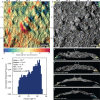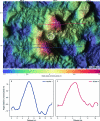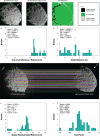Successful kinetic impact into an asteroid for planetary defence
- PMID: 36858073
- PMCID: PMC10115643
- DOI: 10.1038/s41586-023-05810-5
Successful kinetic impact into an asteroid for planetary defence
Abstract
Although no known asteroid poses a threat to Earth for at least the next century, the catalogue of near-Earth asteroids is incomplete for objects whose impacts would produce regional devastation1,2. Several approaches have been proposed to potentially prevent an asteroid impact with Earth by deflecting or disrupting an asteroid1-3. A test of kinetic impact technology was identified as the highest-priority space mission related to asteroid mitigation1. NASA's Double Asteroid Redirection Test (DART) mission is a full-scale test of kinetic impact technology. The mission's target asteroid was Dimorphos, the secondary member of the S-type binary near-Earth asteroid (65803) Didymos. This binary asteroid system was chosen to enable ground-based telescopes to quantify the asteroid deflection caused by the impact of the DART spacecraft4. Although past missions have utilized impactors to investigate the properties of small bodies5,6, those earlier missions were not intended to deflect their targets and did not achieve measurable deflections. Here we report the DART spacecraft's autonomous kinetic impact into Dimorphos and reconstruct the impact event, including the timeline leading to impact, the location and nature of the DART impact site, and the size and shape of Dimorphos. The successful impact of the DART spacecraft with Dimorphos and the resulting change in the orbit of Dimorphos7 demonstrates that kinetic impactor technology is a viable technique to potentially defend Earth if necessary.
© 2023. The Author(s).
Conflict of interest statement
The authors declare no competing interests.
Figures













Comment in
-
DART's data verify its smashing success at deflecting asteroid moon Dimorphos.Nature. 2023 Apr;616(7957):437-438. doi: 10.1038/d41586-023-01020-1. Nature. 2023. PMID: 37076732 No abstract available.
References
-
- Defending Planet Earth: Near-Earth Object Surveys and Hazard Mitigation Strategies (National Academies Press, 2010); 10.17226/12842.
-
- Interagency Working Group for Detecting and Mitigating the Impact of Earth-bound Near-Earth Objects National Near-Earth Object Preparedness Strategy and Action Plan (United States National Science & Technology Council, 2018).
-
- Committee on the Planetary Science and Astrobiology Decadal Survey, Space Studies Board, Division on Engineering and Physical Sciences & National Academies of Sciences, Engineering, and Medicine Origins, Worlds, and Life: A Decadal Strategy for Planetary Science and Astrobiology 2023–2032 (National Academies Press, 2022); 10.17226/26522.
-
- Rivkin AS, et al. The Double Asteroid Redirection Test (DART): planetary defense investigations and requirements. Planet. Sci. J. 2021;2:173. doi: 10.3847/PSJ/ac063e. - DOI
Publication types
Grants and funding
LinkOut - more resources
Full Text Sources
Other Literature Sources
Miscellaneous

